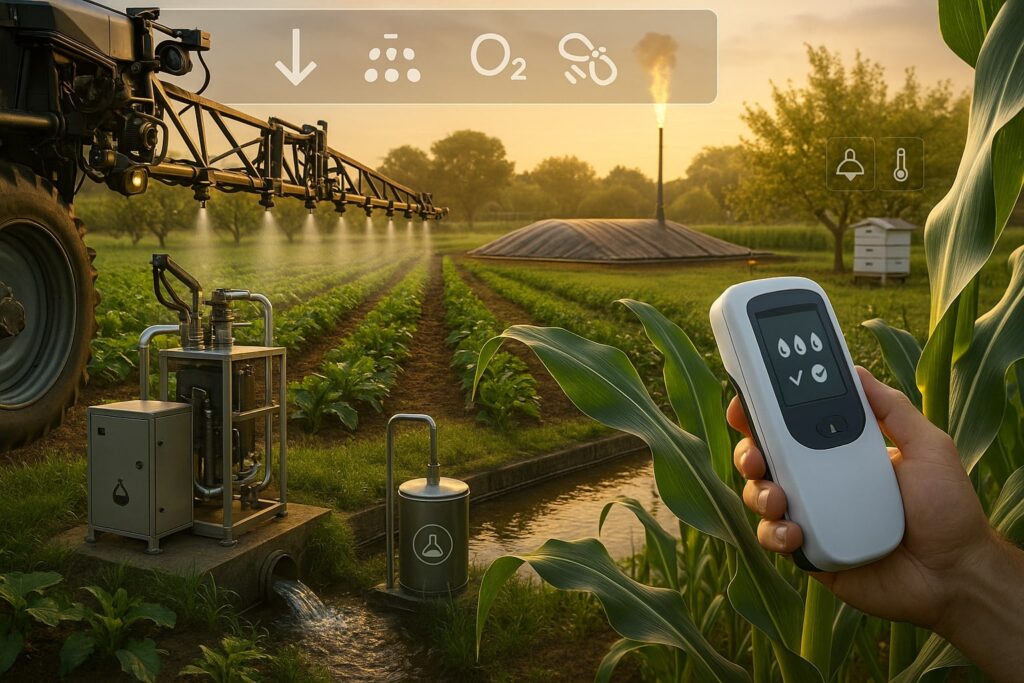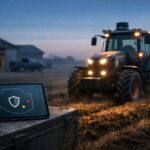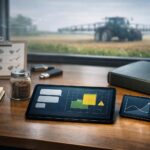New York’s Grow-NY shortlist dropped on 26 August 2025. As ever, twenty startups span everything from upcycled foods to materials science. But five of them speak directly to the lines that decide a farm’s year—chemical spend, fertiliser rates, methane liabilities, and pollination risk. The test between now and the Canandaigua summit on 12–13 November is simple: can they turn a claim into a budget delta in the Grow-NY region and beyond?
Table of Contents
ToggleWhy these five
Two realities frame this year’s selection. First, input costs remain the adoption throttle. Even after the 2022 spike receded, the U.S. farm sector still spent $31.0 billion on fertiliser, lime and soil conditioners in 2023; combined crop inputs (chemicals + fertiliser + seed) were $75.1 billion. Any credible route to use less—or to recover what’s already paid for—deserves attention. Second, state and private programmes are finally attaching hard dollars to methane abatement, turning a liability into an asset if measurement and verification (MRV) hold up.
For a concrete anchor, Iowa State’s 2025 budgets put corn herbicide at $47/acre and herbicide-tolerant soybeans at $70–$77/acre. Trim even half of that on a couple of passes and the savings compound with fewer tote deliveries, water, and labour.
What follows are five finalists that, if they execute, can move those lines.
DeepAgro (Argentina): selective spraying that matters in crop
What it is. DeepAgro’s SprAI uses cameras and AI to trigger nozzles only over weeds—not just on fallow, but in green canopies. The company claims up to 90% reductions in agrochemicals depending on weed pressure. That’s the right ambition: green-on-green at field speeds is the hard problem.
Why it hits the budget. On our Iowa anchor, a 50–70% cut across one post-emergence pass takes a noticeable bite out of that $47/acre corn herbicide line before counting the indirects (tank-mix volume, time, drift risk). Importantly, independent trials with other targeted systems have shown large but variable savings—~76% average across 415 acres in an Iowa State field-scale demonstration—so the ballpark is plausible when weed pressure is low to moderate.
Adoption friction. False negatives at 10–15 mph, lens fouling in dust and dew, camera density per metre of boom—all of this determines whether “demo-day accuracy” survives a season. The broader literature confirms green-on-green is tractable but demanding; ROI depends on pairing with a robust residual programme so the system pays where pressure is low.
What to ask in Canandaigua. Precision/recall metrics at speed, cleaning/maintenance intervals, and retrofit economics per boom section.
(Status: named a 2025 finalist on 26 Aug.)
Picketa Systems (Canada): real-time tissue analysis that removes the lab bottleneck
What it is. LENS™ scans fresh leaf tissue in the field and estimates 13 macro- and micronutrients in minutes, with geotagged results and dashboards for agronomists. The company has expanded beyond potatoes into corn and canola; presentations this year emphasised side-by-side validation against lab assays.
Why it hits the budget. Nitrogen and other nutrients are the largest variable-cost lever in row crops. If tissue status becomes a scouting habit (not a once-a-month lab chore), rate and timing can be nudged toward sufficiency rather than excess. That’s not just margin—it reduces the volatility of margins because you’re making smaller, better-timed bets when fertiliser price whipsaws.
Adoption friction. Calibration credibility across cultivars and growth stages is everything. Agronomists will ask for root-mean-square error versus accredited labs and for decision thresholds baked into the app—not merely pretty charts. Integration into Ops Center, FieldView and other farm data stacks will be decisive.
What to ask in Canandaigua. Independent RMSE by nutrient and crop, onboarding protocol (how many paired samples to “teach” local conditions), and API hooks.
(Status: named a 2025 finalist on 26 Aug.)

Roca (U.S.): turning wastewater ammonium into fertiliser, on-site
What it is. Roca builds membrane-free electrochemical systems to selectively capture ions—notably ammonium (NH₄⁺)—from high-strength wastewater and recover them as fertiliser salts. The basic physics borrows from battery electrodes. The Grow-NY note is explicit about ammonium removal and fertiliser recovery; Roca’s materials frame it as “replace dilute-and-dispose with recover-and-reuse.”
Why it hits the budget. Two levers: (1) avoiding surcharges and compliance risk on effluent ammonia; and (2) creating on-site N that buffers price spikes and freight. Electrochemical ammonia recovery has matured quickly—recent reviews and studies show high removal and recovery rates with improving energy intensity—making decentralised N plausible where streams are concentrated (dairies, food processors, digestate).
Adoption friction. The spreadsheet killers are kWh per kg-N, electrode life/fouling, and downstream product specs (can it drop into existing application equipment?). Roca will need to show site-class economics rather than a general case.
What to ask in Canandaigua. kWh/kg-N at representative influent concentrations; capex/opex sensitivity to salinity and organics; and whether recovered product meets “farmer-friendly” forms (e.g., ammonium sulfate).
(Status: named a 2025 finalist on 26 Aug.)
Frost Methane (U.S.): cover-and-flare for manure ponds—monetised
What it is. Frost Methane installs and operates flare systems on manure ponds, gets paid via carbon credits, and shares revenue with farm partners. The model is turnkey: “we own, install and maintain the equipment at no cost.”
Why it hits the budget. There’s real climate math here. A UC Riverside field study this summer measured ~80% methane reductions after a dairy sealed and captured lagoon emissions—aligning with state modelling. While Frost’s projects flare rather than upgrade to RNG, the core accounting is the same: measured methane avoided/destroyed. Where programme rules buy those tonnes at attractive prices, this is a new revenue line rather than a pure cost.
Adoption friction. Credit quality and MRV. California-style manure credits are under scrutiny for additionality, fence-line impacts and leakage. Expect questions on methodology, metering, and community safeguards. Small and mid-size dairies will look for low-capex participation and predictable revenue sharing.
What to ask in Canandaigua. Which registries and protocols they’ll use; instrumentation and verification cadence; and minimum pond size for positive unit economics in New York policy conditions.
(Status: named a 2025 finalist on 26 Aug.)
Pollen Patrollers / PollenSmartHive (Kenya): precision pollination as a service
What it is. An AI-enabled smart hive and precision pollination placement service for smallholders, using telemetry (temperature, sound, activity) and bloom mapping. The Grow-NY listing appears under PollenSmartHive Ltd with the Pollen Patrollers brand. Prior programme materials peg pollination service pricing around US$10/acre in Kenya—aggressively low versus U.S. per-acre pollination costs—hinting at an accessible service model.
Why it hits the budget. In pollination-dependent crops (apples, cherries, blueberries), national field work shows measurable, addressable pollination deficits suppressing yields; targeted hive placement and monitoring is a pragmatic lever, particularly in fragmented landscapes. The macro story is bigger: pollinator-dependent crops represent ~17% of global crop value, but an outsized ~28% of global agricultural trade value—exactly the products where yield and grade show up in P&L and export receipts.
Adoption friction. Growers will ask for quantified lift per hive-acre, service reliability through the season (queen loss, heat stress), and guarantees tied to fruit set/grade. In the U.S., the company will face well-capitalised incumbents; its edge must be affordability + telemetry-driven placement.
What to ask in Canandaigua. Protocols by crop and block; telemetry features (queen status, temperature, sound); and whether a New York pilot is queued for 2026.
(Status: named a 2025 finalist on 26 Aug.)
The simple test: map each claim to a budget line
Do a “budget-line audit” on stage. For each founder, trace the path from claim → practice → line item. For example:
- Selective spraying (DeepAgro): If corn herbicide averages $47/acre, even a 50% cut on one pass is roughly $24/acre saved, plus fewer tote-fills and less time under a tender. Ask how savings vary with initial weed pressure and how the system behaves at speed in dew/dust.
- Real-time tissue (Picketa): The “win” isn’t a prettier dashboard—it’s when N timing/rate is adjusted based on in-field readings during the growth window, avoiding over-application in a year when agchem prices slip or spike. Ask for independent RMSE and API integrations so agronomists aren’t app-hopping.
- Electrochemical N recovery (Roca): The target sites are high-strength streams where ammonia violations or haulage costs bite. The killer slide is kWh/kg-N vs. delivered urea or UAN, with a maintenance schedule that doesn’t require an in-house electrochemist.
- Manure methane (Frost Methane): The climate maths exist; the gating factor is credit quality and long-term flare uptime. Ask which registry/methodology underpins their credit sales and how they handle pond rain events and odour co-benefits.
- Precision pollination (Pollen Patrollers): Tie telemetry to fruit-set and grade improvements and show a per-acre service price that pencils in specialty blocks. The trade angle (pollinator-dependent goods dominate ag trade value) is your board-level hook.
What others may miss—and you shouldn’t
- In-crop matters more than fallow. Many targeted-spray systems shine on bare ground; the durable ROI appears when green-on-green works at field speeds through a season, not just in demo plots.
- Analytics must trigger decisions, not reports. Picketa’s credibility turns on demonstrable changes in rates/timing and on third-party validation, not only vendor case studies.
- Decentralised nitrogen is a niche scalpel, not a urea killer. Expect early traction in dairies, cheese plants and digestate polishing where streams are concentrated and compliance risk is real.
- Methane credits carry policy risk. The UC Riverside result is a tailwind; the market debate on livestock credits remains live and requires robust MRV and local safeguards.
- Pollination is an export story. Pollinator-dependent crops are a minority by volume but a majority by value in trade; a few percentage points of yield/quality swing headlines and contracts.
Timeline and the Upstate New York lens
By design, Grow-NY requires finalists to commit jobs, partnerships or operations within a 22-county region. That’s a feature, not a bug: the region’s dairies, fruit blocks, processors and research stations are an ideal testbed for “measure-reduce-recover-monetise” plays. Between now and 12–13 November, look for pilot sites (a dairy lagoon, a processor’s centrate stream, a Lake Ontario fruit block) where results can be measured and replicated.




